Strategic Analysis and Restructuring Plan for Air Algerie
VerifiedAdded on 2023/06/10
|46
|11440
|413
Report
AI Summary
This report provides a comprehensive analysis of Air Algerie's performance, focusing on its financial standing, market share, and competitive position. It begins with an overview of the airline industry, highlighting the impact of airline regulations and deregulation. The study examines Air Algerie's organizational structure, strategic plans, destinations, and key competitors. Through financial ratio analysis, including net working capital, current ratio, and asset turnover, the report assesses the airline's financial health. It delves into cost determinants, differentiating between direct and indirect operating costs, and analyzes fixed versus variable costs. The report also evaluates the impact of aircraft acquisitions and productivity metrics, while addressing risk management strategies related to exchange rate volatility and fuel price exposure. Finally, the report proposes solutions and implementation strategies, including leveraging internet sales, managing passenger demand, adopting operational best practices, and exploring market opportunities in Africa, the UK (post-Brexit), and the Americas. The report concludes with recommendations for optimizing Algiers as a hub and spoke model and expanding into the freight market, providing a detailed roadmap for Air Algerie's restructuring and improved performance. Desklib is a platform where you can find past papers and solved assignments.
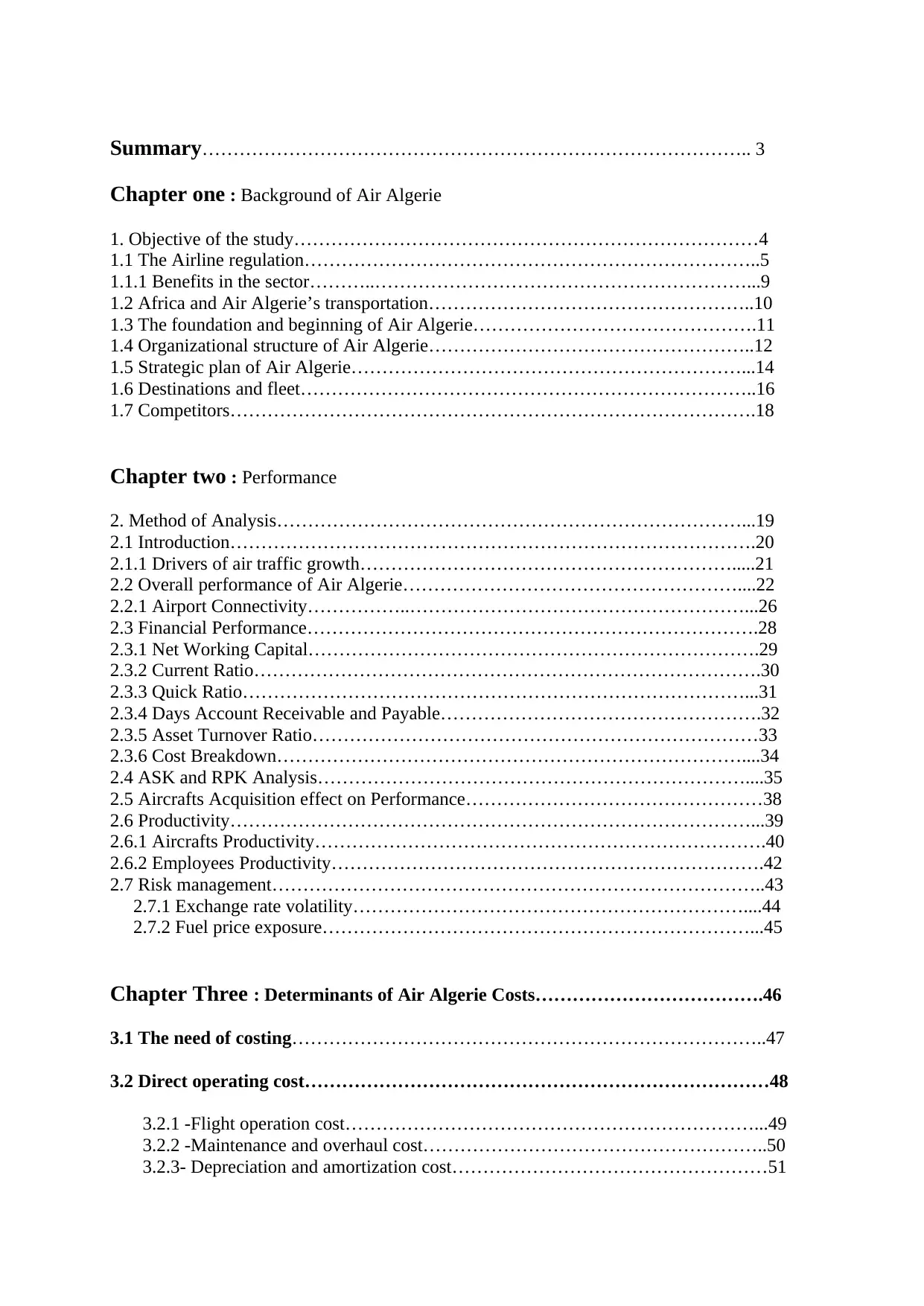
Summary…………………………………………………………………………….. 3
Chapter one : Background of Air Algerie
1. Objective of the study…………………………………………………………………4
1.1 The Airline regulation………………………………………………………………..5
1.1.1 Benefits in the sector………..……………………………………………………...9
1.2 Africa and Air Algerie’s transportation……………………………………………..10
1.3 The foundation and beginning of Air Algerie……………………………………….11
1.4 Organizational structure of Air Algerie……………………………………………..12
1.5 Strategic plan of Air Algerie………………………………………………………...14
1.6 Destinations and fleet………………………………………………………………..16
1.7 Competitors………………………………………………………………………….18
Chapter two : Performance
2. Method of Analysis…………………………………………………………………...19
2.1 Introduction………………………………………………………………………….20
2.1.1 Drivers of air traffic growth…………………………………………………….....21
2.2 Overall performance of Air Algerie………………………………………………....22
2.2.1 Airport Connectivity……………..………………………………………………...26
2.3 Financial Performance……………………………………………………………….28
2.3.1 Net Working Capital……………………………………………………………….29
2.3.2 Current Ratio……………………………………………………………………….30
2.3.3 Quick Ratio………………………………………………………………………...31
2.3.4 Days Account Receivable and Payable…………………………………………….32
2.3.5 Asset Turnover Ratio………………………………………………………………33
2.3.6 Cost Breakdown…………………………………………………………………....34
2.4 ASK and RPK Analysis……………………………………………………………....35
2.5 Aircrafts Acquisition effect on Performance…………………………………………38
2.6 Productivity…………………………………………………………………………...39
2.6.1 Aircrafts Productivity……………………………………………………………….40
2.6.2 Employees Productivity…………………………………………………………….42
2.7 Risk management……………………………………………………………………..43
2.7.1 Exchange rate volatility………………………………………………………....44
2.7.2 Fuel price exposure……………………………………………………………...45
Chapter Three : Determinants of Air Algerie Costs……………………………….46
3.1 The need of costing…………………………………………………………………..47
3.2 Direct operating cost…………………………………………………………………48
3.2.1 -Flight operation cost…………………………………………………………...49
3.2.2 -Maintenance and overhaul cost………………………………………………..50
3.2.3- Depreciation and amortization cost……………………………………………51
Chapter one : Background of Air Algerie
1. Objective of the study…………………………………………………………………4
1.1 The Airline regulation………………………………………………………………..5
1.1.1 Benefits in the sector………..……………………………………………………...9
1.2 Africa and Air Algerie’s transportation……………………………………………..10
1.3 The foundation and beginning of Air Algerie……………………………………….11
1.4 Organizational structure of Air Algerie……………………………………………..12
1.5 Strategic plan of Air Algerie………………………………………………………...14
1.6 Destinations and fleet………………………………………………………………..16
1.7 Competitors………………………………………………………………………….18
Chapter two : Performance
2. Method of Analysis…………………………………………………………………...19
2.1 Introduction………………………………………………………………………….20
2.1.1 Drivers of air traffic growth…………………………………………………….....21
2.2 Overall performance of Air Algerie………………………………………………....22
2.2.1 Airport Connectivity……………..………………………………………………...26
2.3 Financial Performance……………………………………………………………….28
2.3.1 Net Working Capital……………………………………………………………….29
2.3.2 Current Ratio……………………………………………………………………….30
2.3.3 Quick Ratio………………………………………………………………………...31
2.3.4 Days Account Receivable and Payable…………………………………………….32
2.3.5 Asset Turnover Ratio………………………………………………………………33
2.3.6 Cost Breakdown…………………………………………………………………....34
2.4 ASK and RPK Analysis……………………………………………………………....35
2.5 Aircrafts Acquisition effect on Performance…………………………………………38
2.6 Productivity…………………………………………………………………………...39
2.6.1 Aircrafts Productivity……………………………………………………………….40
2.6.2 Employees Productivity…………………………………………………………….42
2.7 Risk management……………………………………………………………………..43
2.7.1 Exchange rate volatility………………………………………………………....44
2.7.2 Fuel price exposure……………………………………………………………...45
Chapter Three : Determinants of Air Algerie Costs……………………………….46
3.1 The need of costing…………………………………………………………………..47
3.2 Direct operating cost…………………………………………………………………48
3.2.1 -Flight operation cost…………………………………………………………...49
3.2.2 -Maintenance and overhaul cost………………………………………………..50
3.2.3- Depreciation and amortization cost……………………………………………51
Paraphrase This Document
Need a fresh take? Get an instant paraphrase of this document with our AI Paraphraser
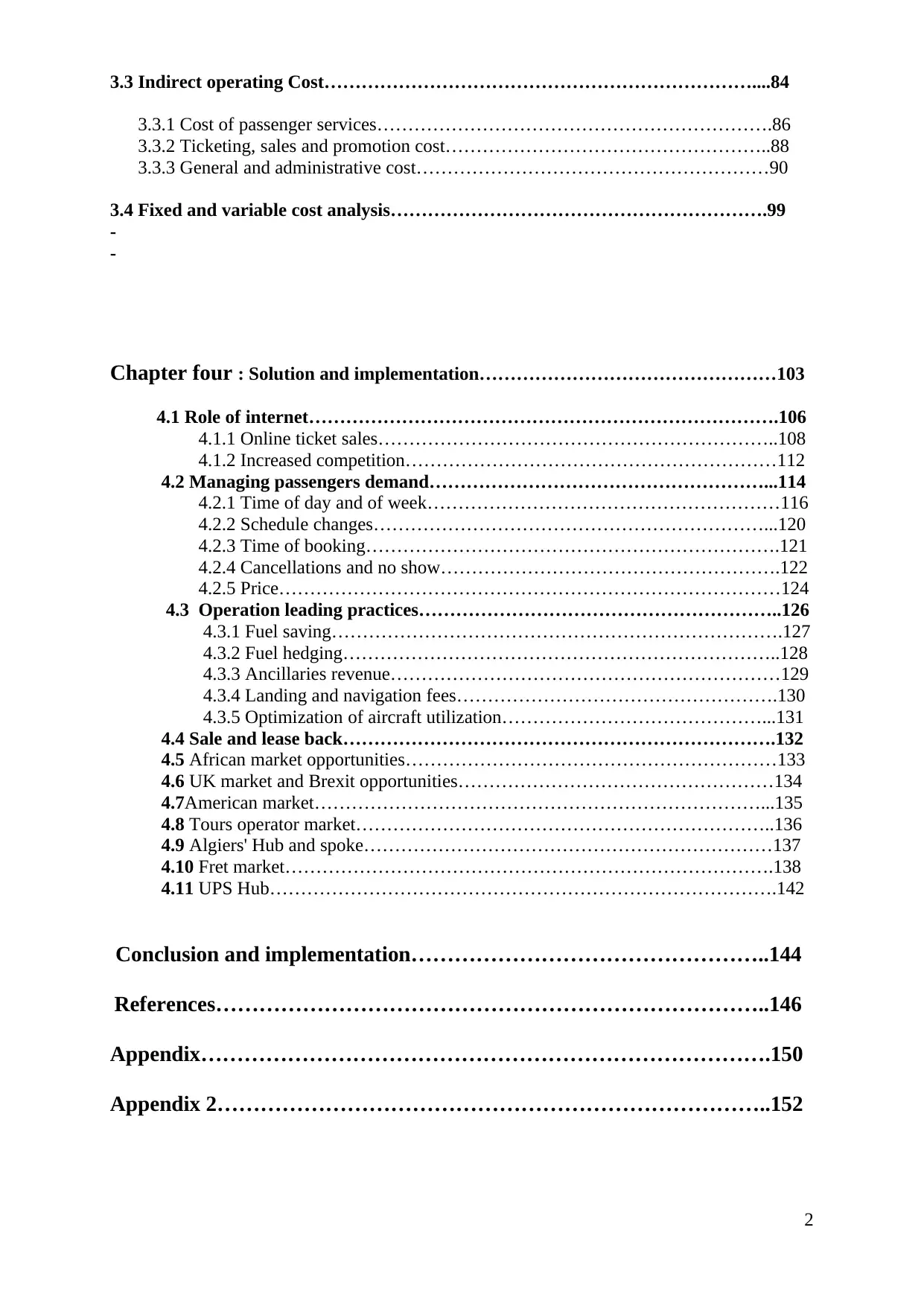
3.3 Indirect operating Cost……………………………………………………………....84
3.3.1 Cost of passenger services……………………………………………………….86
3.3.2 Ticketing, sales and promotion cost……………………………………………..88
3.3.3 General and administrative cost…………………………………………………90
3.4 Fixed and variable cost analysis…………………………………………………….99
-
-
Chapter four : Solution and implementation…………………………………………103
4.1 Role of internet………………………………………………………………….106
4.1.1 Online ticket sales………………………………………………………..108
4.1.2 Increased competition……………………………………………………112
4.2 Managing passengers demand………………………………………………...114
4.2.1 Time of day and of week…………………………………………………116
4.2.2 Schedule changes………………………………………………………...120
4.2.3 Time of booking………………………………………………………….121
4.2.4 Cancellations and no show……………………………………………….122
4.2.5 Price………………………………………………………………………124
4.3 Operation leading practices…………………………………………………..126
4.3.1 Fuel saving……………………………………………………………….127
4.3.2 Fuel hedging……………………………………………………………..128
4.3.3 Ancillaries revenue………………………………………………………129
4.3.4 Landing and navigation fees…………………………………………….130
4.3.5 Optimization of aircraft utilization……………………………………...131
4.4 Sale and lease back…………………………………………………………….132
4.5 African market opportunities……………………………………………………133
4.6 UK market and Brexit opportunities……………………………………………134
4.7American market………………………………………………………………...135
4.8 Tours operator market…………………………………………………………..136
4.9 Algiers' Hub and spoke…………………………………………………………137
4.10 Fret market…………………………………………………………………….138
4.11 UPS Hub……………………………………………………………………….142
Conclusion and implementation…………………………………………..144
References…………………………………………………………………..146
Appendix…………………………………………………………………….150
Appendix 2…………………………………………………………………..152
2
3.3.1 Cost of passenger services……………………………………………………….86
3.3.2 Ticketing, sales and promotion cost……………………………………………..88
3.3.3 General and administrative cost…………………………………………………90
3.4 Fixed and variable cost analysis…………………………………………………….99
-
-
Chapter four : Solution and implementation…………………………………………103
4.1 Role of internet………………………………………………………………….106
4.1.1 Online ticket sales………………………………………………………..108
4.1.2 Increased competition……………………………………………………112
4.2 Managing passengers demand………………………………………………...114
4.2.1 Time of day and of week…………………………………………………116
4.2.2 Schedule changes………………………………………………………...120
4.2.3 Time of booking………………………………………………………….121
4.2.4 Cancellations and no show……………………………………………….122
4.2.5 Price………………………………………………………………………124
4.3 Operation leading practices…………………………………………………..126
4.3.1 Fuel saving……………………………………………………………….127
4.3.2 Fuel hedging……………………………………………………………..128
4.3.3 Ancillaries revenue………………………………………………………129
4.3.4 Landing and navigation fees…………………………………………….130
4.3.5 Optimization of aircraft utilization……………………………………...131
4.4 Sale and lease back…………………………………………………………….132
4.5 African market opportunities……………………………………………………133
4.6 UK market and Brexit opportunities……………………………………………134
4.7American market………………………………………………………………...135
4.8 Tours operator market…………………………………………………………..136
4.9 Algiers' Hub and spoke…………………………………………………………137
4.10 Fret market…………………………………………………………………….138
4.11 UPS Hub……………………………………………………………………….142
Conclusion and implementation…………………………………………..144
References…………………………………………………………………..146
Appendix…………………………………………………………………….150
Appendix 2…………………………………………………………………..152
2
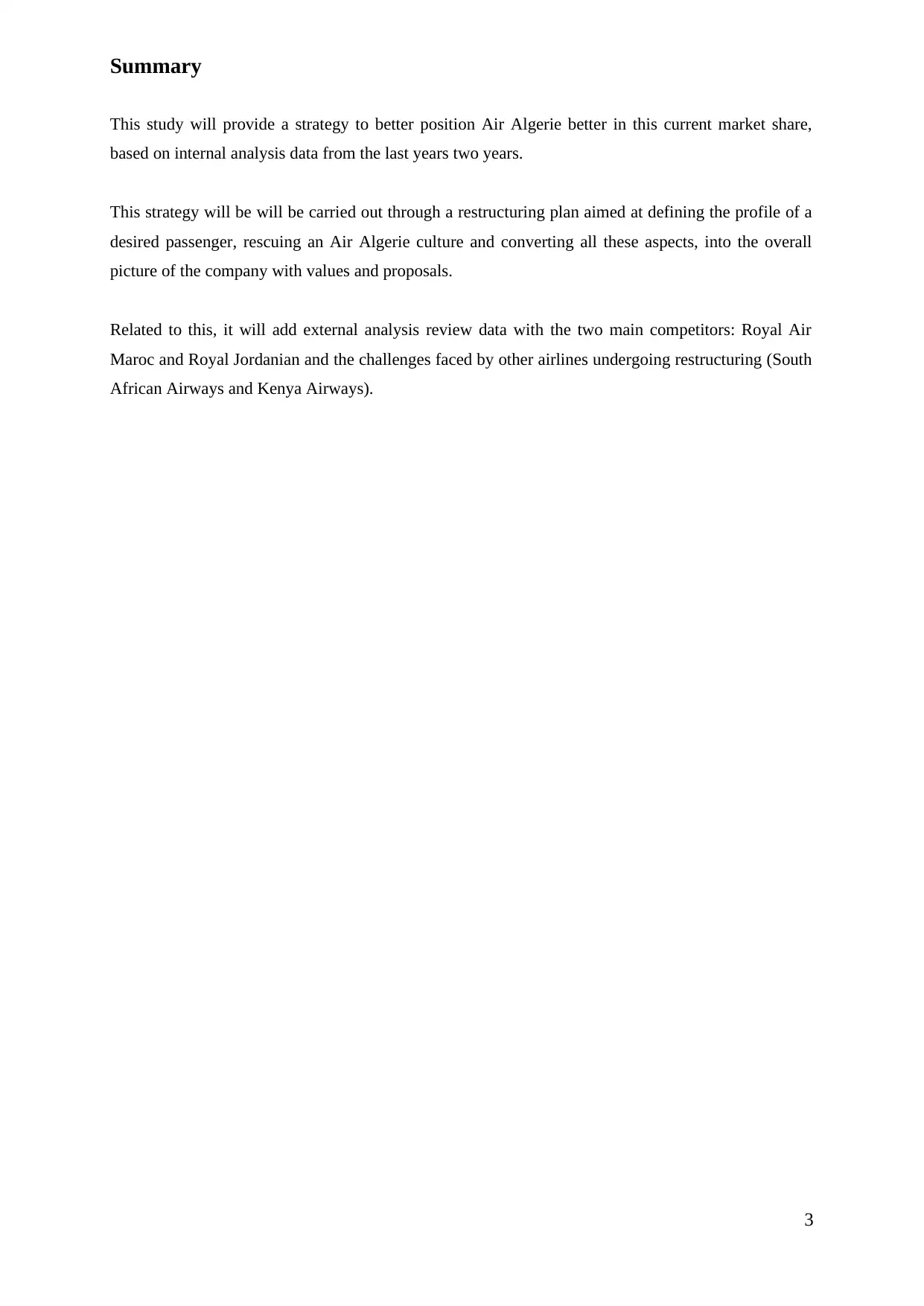
Summary
This study will provide a strategy to better position Air Algerie better in this current market share,
based on internal analysis data from the last years two years.
This strategy will be will be carried out through a restructuring plan aimed at defining the profile of a
desired passenger, rescuing an Air Algerie culture and converting all these aspects, into the overall
picture of the company with values and proposals.
Related to this, it will add external analysis review data with the two main competitors: Royal Air
Maroc and Royal Jordanian and the challenges faced by other airlines undergoing restructuring (South
African Airways and Kenya Airways).
3
This study will provide a strategy to better position Air Algerie better in this current market share,
based on internal analysis data from the last years two years.
This strategy will be will be carried out through a restructuring plan aimed at defining the profile of a
desired passenger, rescuing an Air Algerie culture and converting all these aspects, into the overall
picture of the company with values and proposals.
Related to this, it will add external analysis review data with the two main competitors: Royal Air
Maroc and Royal Jordanian and the challenges faced by other airlines undergoing restructuring (South
African Airways and Kenya Airways).
3
⊘ This is a preview!⊘
Do you want full access?
Subscribe today to unlock all pages.

Trusted by 1+ million students worldwide
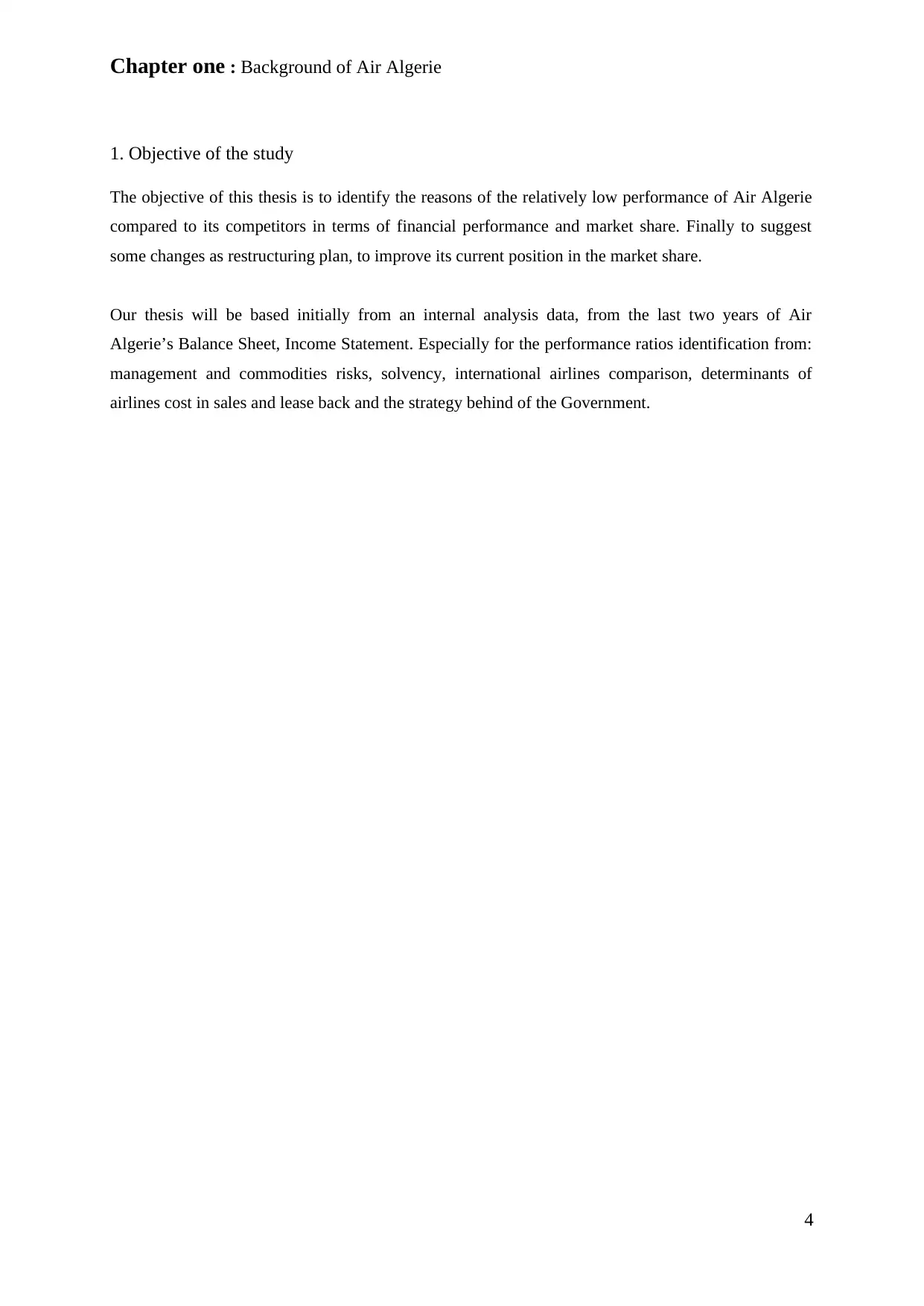
Chapter one : Background of Air Algerie
1. Objective of the study
The objective of this thesis is to identify the reasons of the relatively low performance of Air Algerie
compared to its competitors in terms of financial performance and market share. Finally to suggest
some changes as restructuring plan, to improve its current position in the market share.
Our thesis will be based initially from an internal analysis data, from the last two years of Air
Algerie’s Balance Sheet, Income Statement. Especially for the performance ratios identification from:
management and commodities risks, solvency, international airlines comparison, determinants of
airlines cost in sales and lease back and the strategy behind of the Government.
4
1. Objective of the study
The objective of this thesis is to identify the reasons of the relatively low performance of Air Algerie
compared to its competitors in terms of financial performance and market share. Finally to suggest
some changes as restructuring plan, to improve its current position in the market share.
Our thesis will be based initially from an internal analysis data, from the last two years of Air
Algerie’s Balance Sheet, Income Statement. Especially for the performance ratios identification from:
management and commodities risks, solvency, international airlines comparison, determinants of
airlines cost in sales and lease back and the strategy behind of the Government.
4
Paraphrase This Document
Need a fresh take? Get an instant paraphrase of this document with our AI Paraphraser
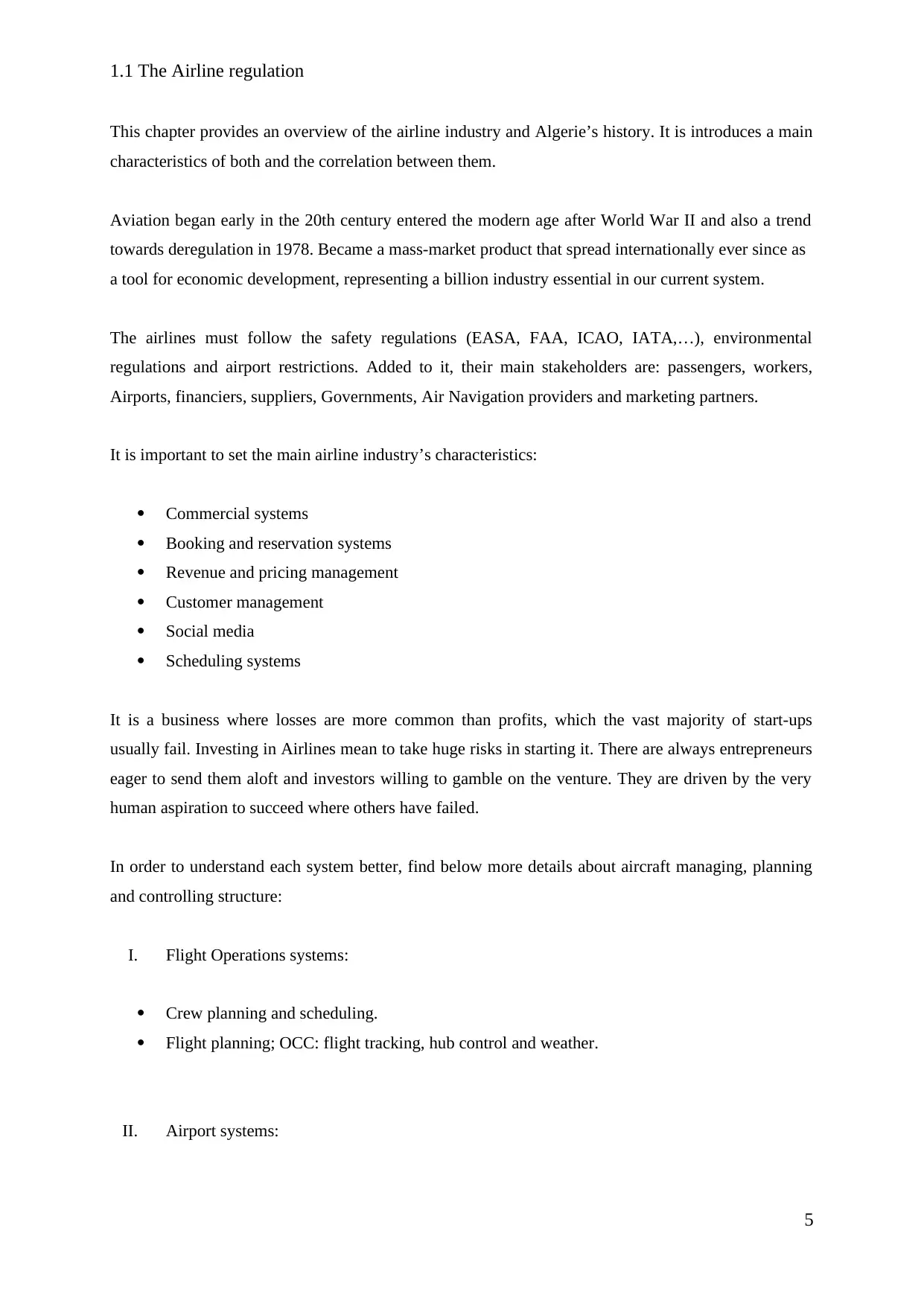
1.1 The Airline regulation
This chapter provides an overview of the airline industry and Algerie’s history. It is introduces a main
characteristics of both and the correlation between them.
Aviation began early in the 20th century entered the modern age after World War II and also a trend
towards deregulation in 1978. Became a mass-market product that spread internationally ever since as
a tool for economic development, representing a billion industry essential in our current system.
The airlines must follow the safety regulations (EASA, FAA, ICAO, IATA,…), environmental
regulations and airport restrictions. Added to it, their main stakeholders are: passengers, workers,
Airports, financiers, suppliers, Governments, Air Navigation providers and marketing partners.
It is important to set the main airline industry’s characteristics:
Commercial systems
Booking and reservation systems
Revenue and pricing management
Customer management
Social media
Scheduling systems
It is a business where losses are more common than profits, which the vast majority of start-ups
usually fail. Investing in Airlines mean to take huge risks in starting it. There are always entrepreneurs
eager to send them aloft and investors willing to gamble on the venture. They are driven by the very
human aspiration to succeed where others have failed.
In order to understand each system better, find below more details about aircraft managing, planning
and controlling structure:
I. Flight Operations systems:
Crew planning and scheduling.
Flight planning; OCC: flight tracking, hub control and weather.
II. Airport systems:
5
This chapter provides an overview of the airline industry and Algerie’s history. It is introduces a main
characteristics of both and the correlation between them.
Aviation began early in the 20th century entered the modern age after World War II and also a trend
towards deregulation in 1978. Became a mass-market product that spread internationally ever since as
a tool for economic development, representing a billion industry essential in our current system.
The airlines must follow the safety regulations (EASA, FAA, ICAO, IATA,…), environmental
regulations and airport restrictions. Added to it, their main stakeholders are: passengers, workers,
Airports, financiers, suppliers, Governments, Air Navigation providers and marketing partners.
It is important to set the main airline industry’s characteristics:
Commercial systems
Booking and reservation systems
Revenue and pricing management
Customer management
Social media
Scheduling systems
It is a business where losses are more common than profits, which the vast majority of start-ups
usually fail. Investing in Airlines mean to take huge risks in starting it. There are always entrepreneurs
eager to send them aloft and investors willing to gamble on the venture. They are driven by the very
human aspiration to succeed where others have failed.
In order to understand each system better, find below more details about aircraft managing, planning
and controlling structure:
I. Flight Operations systems:
Crew planning and scheduling.
Flight planning; OCC: flight tracking, hub control and weather.
II. Airport systems:
5
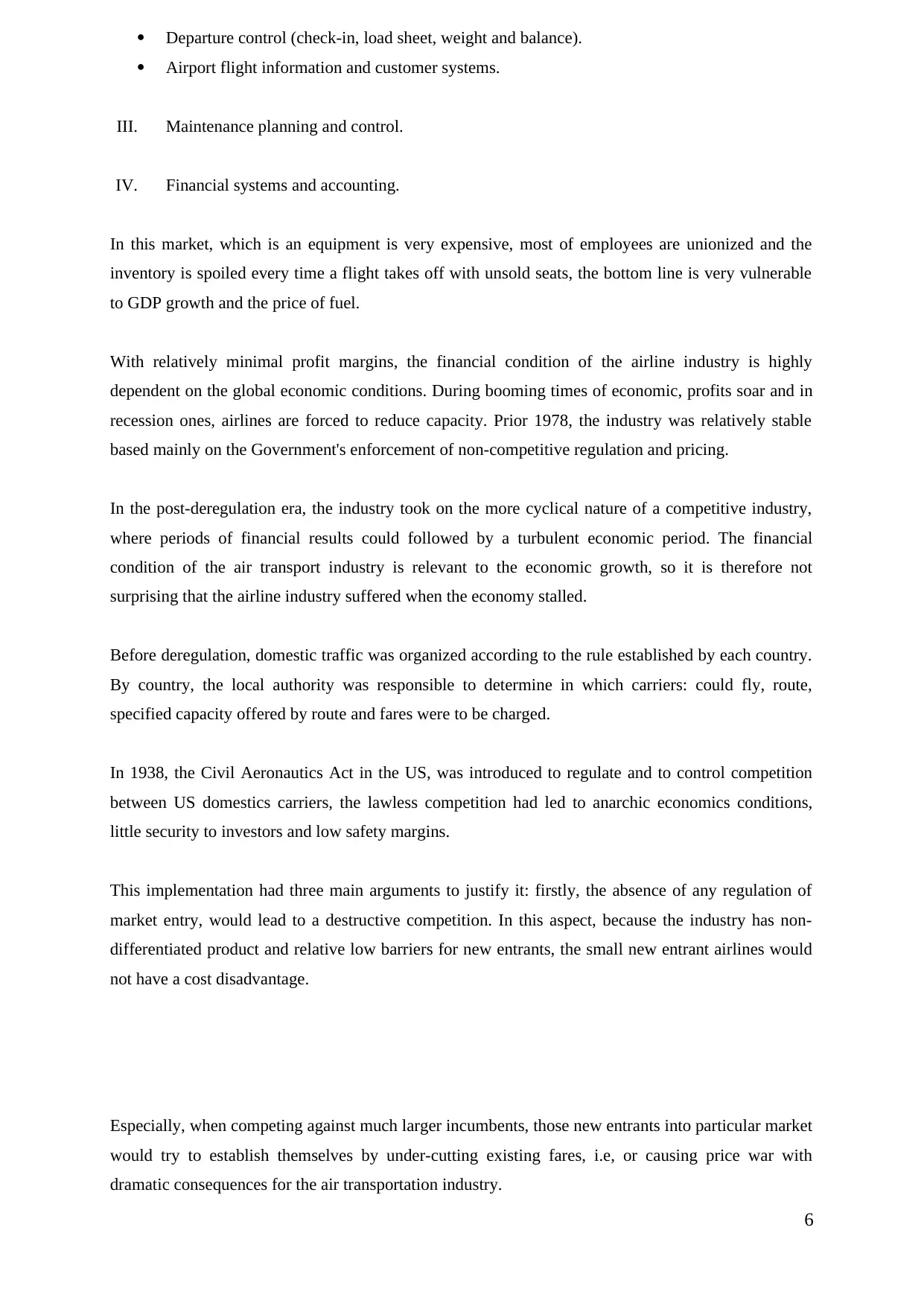
Departure control (check-in, load sheet, weight and balance).
Airport flight information and customer systems.
III. Maintenance planning and control.
IV. Financial systems and accounting.
In this market, which is an equipment is very expensive, most of employees are unionized and the
inventory is spoiled every time a flight takes off with unsold seats, the bottom line is very vulnerable
to GDP growth and the price of fuel.
With relatively minimal profit margins, the financial condition of the airline industry is highly
dependent on the global economic conditions. During booming times of economic, profits soar and in
recession ones, airlines are forced to reduce capacity. Prior 1978, the industry was relatively stable
based mainly on the Government's enforcement of non-competitive regulation and pricing.
In the post-deregulation era, the industry took on the more cyclical nature of a competitive industry,
where periods of financial results could followed by a turbulent economic period. The financial
condition of the air transport industry is relevant to the economic growth, so it is therefore not
surprising that the airline industry suffered when the economy stalled.
Before deregulation, domestic traffic was organized according to the rule established by each country.
By country, the local authority was responsible to determine in which carriers: could fly, route,
specified capacity offered by route and fares were to be charged.
In 1938, the Civil Aeronautics Act in the US, was introduced to regulate and to control competition
between US domestics carriers, the lawless competition had led to anarchic economics conditions,
little security to investors and low safety margins.
This implementation had three main arguments to justify it: firstly, the absence of any regulation of
market entry, would lead to a destructive competition. In this aspect, because the industry has non-
differentiated product and relative low barriers for new entrants, the small new entrant airlines would
not have a cost disadvantage.
Especially, when competing against much larger incumbents, those new entrants into particular market
would try to establish themselves by under-cutting existing fares, i.e, or causing price war with
dramatic consequences for the air transportation industry.
6
Airport flight information and customer systems.
III. Maintenance planning and control.
IV. Financial systems and accounting.
In this market, which is an equipment is very expensive, most of employees are unionized and the
inventory is spoiled every time a flight takes off with unsold seats, the bottom line is very vulnerable
to GDP growth and the price of fuel.
With relatively minimal profit margins, the financial condition of the airline industry is highly
dependent on the global economic conditions. During booming times of economic, profits soar and in
recession ones, airlines are forced to reduce capacity. Prior 1978, the industry was relatively stable
based mainly on the Government's enforcement of non-competitive regulation and pricing.
In the post-deregulation era, the industry took on the more cyclical nature of a competitive industry,
where periods of financial results could followed by a turbulent economic period. The financial
condition of the air transport industry is relevant to the economic growth, so it is therefore not
surprising that the airline industry suffered when the economy stalled.
Before deregulation, domestic traffic was organized according to the rule established by each country.
By country, the local authority was responsible to determine in which carriers: could fly, route,
specified capacity offered by route and fares were to be charged.
In 1938, the Civil Aeronautics Act in the US, was introduced to regulate and to control competition
between US domestics carriers, the lawless competition had led to anarchic economics conditions,
little security to investors and low safety margins.
This implementation had three main arguments to justify it: firstly, the absence of any regulation of
market entry, would lead to a destructive competition. In this aspect, because the industry has non-
differentiated product and relative low barriers for new entrants, the small new entrant airlines would
not have a cost disadvantage.
Especially, when competing against much larger incumbents, those new entrants into particular market
would try to establish themselves by under-cutting existing fares, i.e, or causing price war with
dramatic consequences for the air transportation industry.
6
⊘ This is a preview!⊘
Do you want full access?
Subscribe today to unlock all pages.

Trusted by 1+ million students worldwide
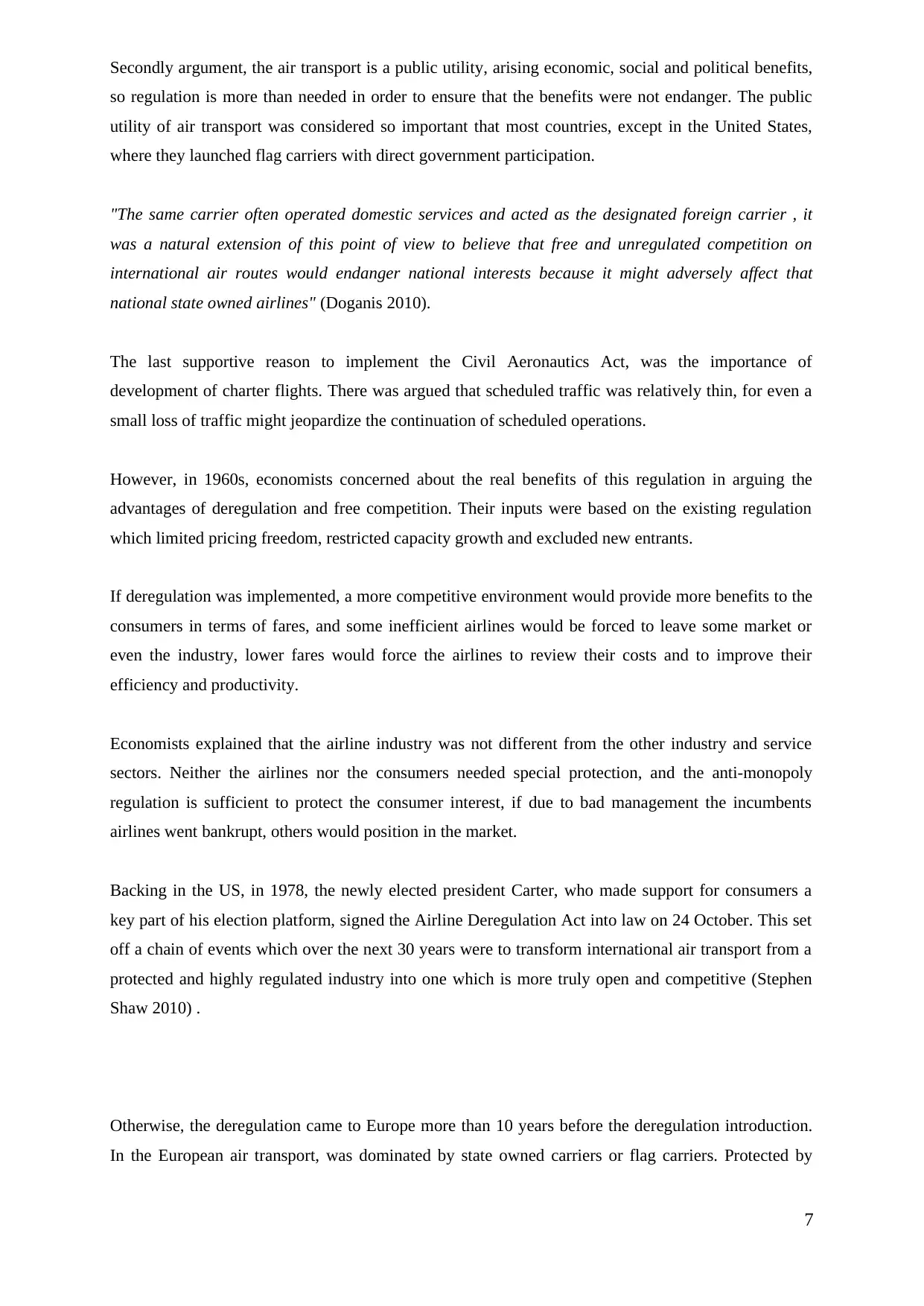
Secondly argument, the air transport is a public utility, arising economic, social and political benefits,
so regulation is more than needed in order to ensure that the benefits were not endanger. The public
utility of air transport was considered so important that most countries, except in the United States,
where they launched flag carriers with direct government participation.
"The same carrier often operated domestic services and acted as the designated foreign carrier , it
was a natural extension of this point of view to believe that free and unregulated competition on
international air routes would endanger national interests because it might adversely affect that
national state owned airlines" (Doganis 2010).
The last supportive reason to implement the Civil Aeronautics Act, was the importance of
development of charter flights. There was argued that scheduled traffic was relatively thin, for even a
small loss of traffic might jeopardize the continuation of scheduled operations.
However, in 1960s, economists concerned about the real benefits of this regulation in arguing the
advantages of deregulation and free competition. Their inputs were based on the existing regulation
which limited pricing freedom, restricted capacity growth and excluded new entrants.
If deregulation was implemented, a more competitive environment would provide more benefits to the
consumers in terms of fares, and some inefficient airlines would be forced to leave some market or
even the industry, lower fares would force the airlines to review their costs and to improve their
efficiency and productivity.
Economists explained that the airline industry was not different from the other industry and service
sectors. Neither the airlines nor the consumers needed special protection, and the anti-monopoly
regulation is sufficient to protect the consumer interest, if due to bad management the incumbents
airlines went bankrupt, others would position in the market.
Backing in the US, in 1978, the newly elected president Carter, who made support for consumers a
key part of his election platform, signed the Airline Deregulation Act into law on 24 October. This set
off a chain of events which over the next 30 years were to transform international air transport from a
protected and highly regulated industry into one which is more truly open and competitive (Stephen
Shaw 2010) .
Otherwise, the deregulation came to Europe more than 10 years before the deregulation introduction.
In the European air transport, was dominated by state owned carriers or flag carriers. Protected by
7
so regulation is more than needed in order to ensure that the benefits were not endanger. The public
utility of air transport was considered so important that most countries, except in the United States,
where they launched flag carriers with direct government participation.
"The same carrier often operated domestic services and acted as the designated foreign carrier , it
was a natural extension of this point of view to believe that free and unregulated competition on
international air routes would endanger national interests because it might adversely affect that
national state owned airlines" (Doganis 2010).
The last supportive reason to implement the Civil Aeronautics Act, was the importance of
development of charter flights. There was argued that scheduled traffic was relatively thin, for even a
small loss of traffic might jeopardize the continuation of scheduled operations.
However, in 1960s, economists concerned about the real benefits of this regulation in arguing the
advantages of deregulation and free competition. Their inputs were based on the existing regulation
which limited pricing freedom, restricted capacity growth and excluded new entrants.
If deregulation was implemented, a more competitive environment would provide more benefits to the
consumers in terms of fares, and some inefficient airlines would be forced to leave some market or
even the industry, lower fares would force the airlines to review their costs and to improve their
efficiency and productivity.
Economists explained that the airline industry was not different from the other industry and service
sectors. Neither the airlines nor the consumers needed special protection, and the anti-monopoly
regulation is sufficient to protect the consumer interest, if due to bad management the incumbents
airlines went bankrupt, others would position in the market.
Backing in the US, in 1978, the newly elected president Carter, who made support for consumers a
key part of his election platform, signed the Airline Deregulation Act into law on 24 October. This set
off a chain of events which over the next 30 years were to transform international air transport from a
protected and highly regulated industry into one which is more truly open and competitive (Stephen
Shaw 2010) .
Otherwise, the deregulation came to Europe more than 10 years before the deregulation introduction.
In the European air transport, was dominated by state owned carriers or flag carriers. Protected by
7
Paraphrase This Document
Need a fresh take? Get an instant paraphrase of this document with our AI Paraphraser
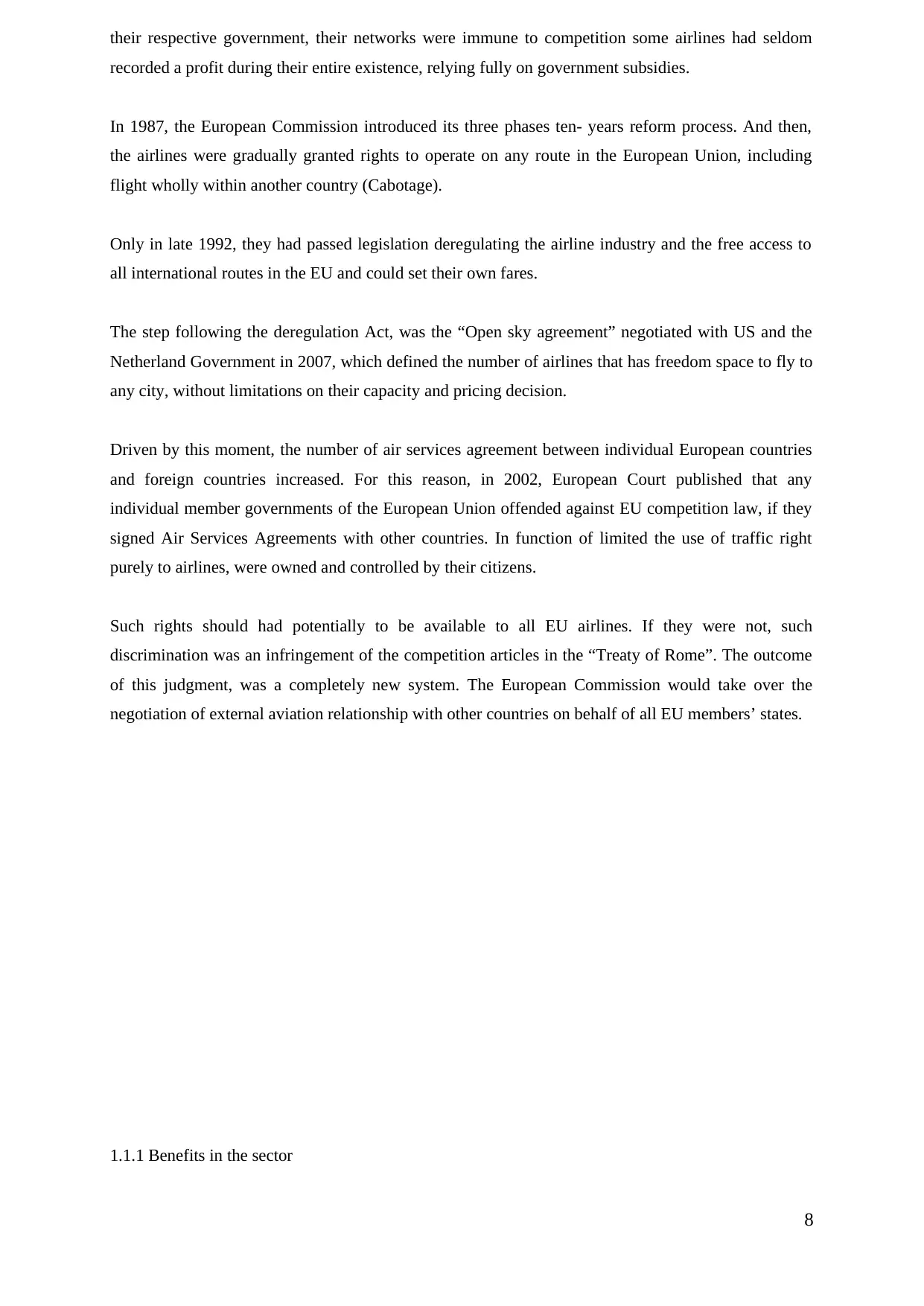
their respective government, their networks were immune to competition some airlines had seldom
recorded a profit during their entire existence, relying fully on government subsidies.
In 1987, the European Commission introduced its three phases ten- years reform process. And then,
the airlines were gradually granted rights to operate on any route in the European Union, including
flight wholly within another country (Cabotage).
Only in late 1992, they had passed legislation deregulating the airline industry and the free access to
all international routes in the EU and could set their own fares.
The step following the deregulation Act, was the “Open sky agreement” negotiated with US and the
Netherland Government in 2007, which defined the number of airlines that has freedom space to fly to
any city, without limitations on their capacity and pricing decision.
Driven by this moment, the number of air services agreement between individual European countries
and foreign countries increased. For this reason, in 2002, European Court published that any
individual member governments of the European Union offended against EU competition law, if they
signed Air Services Agreements with other countries. In function of limited the use of traffic right
purely to airlines, were owned and controlled by their citizens.
Such rights should had potentially to be available to all EU airlines. If they were not, such
discrimination was an infringement of the competition articles in the “Treaty of Rome”. The outcome
of this judgment, was a completely new system. The European Commission would take over the
negotiation of external aviation relationship with other countries on behalf of all EU members’ states.
1.1.1 Benefits in the sector
8
recorded a profit during their entire existence, relying fully on government subsidies.
In 1987, the European Commission introduced its three phases ten- years reform process. And then,
the airlines were gradually granted rights to operate on any route in the European Union, including
flight wholly within another country (Cabotage).
Only in late 1992, they had passed legislation deregulating the airline industry and the free access to
all international routes in the EU and could set their own fares.
The step following the deregulation Act, was the “Open sky agreement” negotiated with US and the
Netherland Government in 2007, which defined the number of airlines that has freedom space to fly to
any city, without limitations on their capacity and pricing decision.
Driven by this moment, the number of air services agreement between individual European countries
and foreign countries increased. For this reason, in 2002, European Court published that any
individual member governments of the European Union offended against EU competition law, if they
signed Air Services Agreements with other countries. In function of limited the use of traffic right
purely to airlines, were owned and controlled by their citizens.
Such rights should had potentially to be available to all EU airlines. If they were not, such
discrimination was an infringement of the competition articles in the “Treaty of Rome”. The outcome
of this judgment, was a completely new system. The European Commission would take over the
negotiation of external aviation relationship with other countries on behalf of all EU members’ states.
1.1.1 Benefits in the sector
8
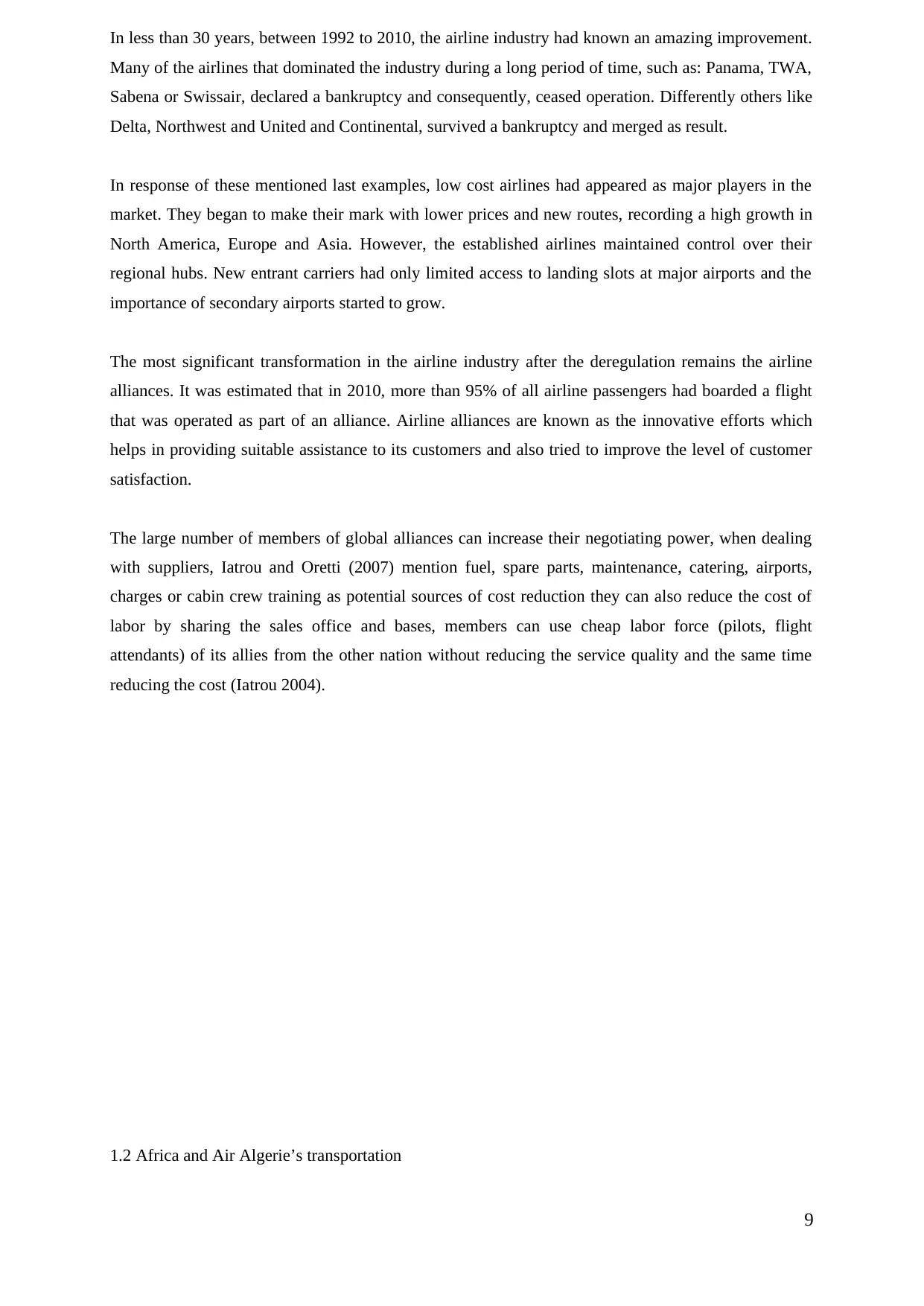
In less than 30 years, between 1992 to 2010, the airline industry had known an amazing improvement.
Many of the airlines that dominated the industry during a long period of time, such as: Panama, TWA,
Sabena or Swissair, declared a bankruptcy and consequently, ceased operation. Differently others like
Delta, Northwest and United and Continental, survived a bankruptcy and merged as result.
In response of these mentioned last examples, low cost airlines had appeared as major players in the
market. They began to make their mark with lower prices and new routes, recording a high growth in
North America, Europe and Asia. However, the established airlines maintained control over their
regional hubs. New entrant carriers had only limited access to landing slots at major airports and the
importance of secondary airports started to grow.
The most significant transformation in the airline industry after the deregulation remains the airline
alliances. It was estimated that in 2010, more than 95% of all airline passengers had boarded a flight
that was operated as part of an alliance. Airline alliances are known as the innovative efforts which
helps in providing suitable assistance to its customers and also tried to improve the level of customer
satisfaction.
The large number of members of global alliances can increase their negotiating power, when dealing
with suppliers, Iatrou and Oretti (2007) mention fuel, spare parts, maintenance, catering, airports,
charges or cabin crew training as potential sources of cost reduction they can also reduce the cost of
labor by sharing the sales office and bases, members can use cheap labor force (pilots, flight
attendants) of its allies from the other nation without reducing the service quality and the same time
reducing the cost (Iatrou 2004).
1.2 Africa and Air Algerie’s transportation
9
Many of the airlines that dominated the industry during a long period of time, such as: Panama, TWA,
Sabena or Swissair, declared a bankruptcy and consequently, ceased operation. Differently others like
Delta, Northwest and United and Continental, survived a bankruptcy and merged as result.
In response of these mentioned last examples, low cost airlines had appeared as major players in the
market. They began to make their mark with lower prices and new routes, recording a high growth in
North America, Europe and Asia. However, the established airlines maintained control over their
regional hubs. New entrant carriers had only limited access to landing slots at major airports and the
importance of secondary airports started to grow.
The most significant transformation in the airline industry after the deregulation remains the airline
alliances. It was estimated that in 2010, more than 95% of all airline passengers had boarded a flight
that was operated as part of an alliance. Airline alliances are known as the innovative efforts which
helps in providing suitable assistance to its customers and also tried to improve the level of customer
satisfaction.
The large number of members of global alliances can increase their negotiating power, when dealing
with suppliers, Iatrou and Oretti (2007) mention fuel, spare parts, maintenance, catering, airports,
charges or cabin crew training as potential sources of cost reduction they can also reduce the cost of
labor by sharing the sales office and bases, members can use cheap labor force (pilots, flight
attendants) of its allies from the other nation without reducing the service quality and the same time
reducing the cost (Iatrou 2004).
1.2 Africa and Air Algerie’s transportation
9
⊘ This is a preview!⊘
Do you want full access?
Subscribe today to unlock all pages.

Trusted by 1+ million students worldwide
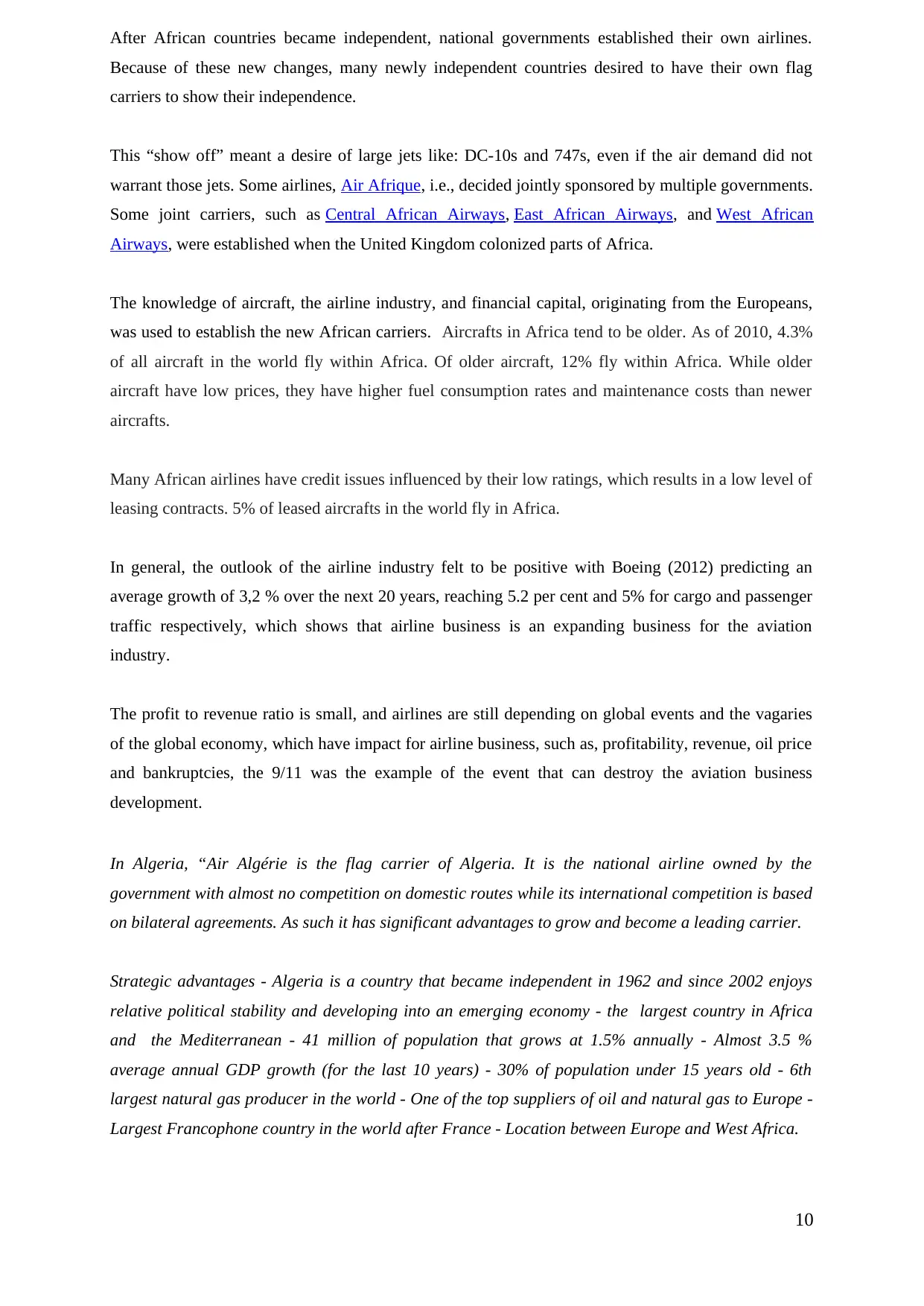
After African countries became independent, national governments established their own airlines.
Because of these new changes, many newly independent countries desired to have their own flag
carriers to show their independence.
This “show off” meant a desire of large jets like: DC-10s and 747s, even if the air demand did not
warrant those jets. Some airlines, Air Afrique, i.e., decided jointly sponsored by multiple governments.
Some joint carriers, such as Central African Airways, East African Airways, and West African
Airways, were established when the United Kingdom colonized parts of Africa.
The knowledge of aircraft, the airline industry, and financial capital, originating from the Europeans,
was used to establish the new African carriers. Aircrafts in Africa tend to be older. As of 2010, 4.3%
of all aircraft in the world fly within Africa. Of older aircraft, 12% fly within Africa. While older
aircraft have low prices, they have higher fuel consumption rates and maintenance costs than newer
aircrafts.
Many African airlines have credit issues influenced by their low ratings, which results in a low level of
leasing contracts. 5% of leased aircrafts in the world fly in Africa.
In general, the outlook of the airline industry felt to be positive with Boeing (2012) predicting an
average growth of 3,2 % over the next 20 years, reaching 5.2 per cent and 5% for cargo and passenger
traffic respectively, which shows that airline business is an expanding business for the aviation
industry.
The profit to revenue ratio is small, and airlines are still depending on global events and the vagaries
of the global economy, which have impact for airline business, such as, profitability, revenue, oil price
and bankruptcies, the 9/11 was the example of the event that can destroy the aviation business
development.
In Algeria, “Air Algérie is the flag carrier of Algeria. It is the national airline owned by the
government with almost no competition on domestic routes while its international competition is based
on bilateral agreements. As such it has significant advantages to grow and become a leading carrier.
Strategic advantages - Algeria is a country that became independent in 1962 and since 2002 enjoys
relative political stability and developing into an emerging economy - the largest country in Africa
and the Mediterranean - 41 million of population that grows at 1.5% annually - Almost 3.5 %
average annual GDP growth (for the last 10 years) - 30% of population under 15 years old - 6th
largest natural gas producer in the world - One of the top suppliers of oil and natural gas to Europe -
Largest Francophone country in the world after France - Location between Europe and West Africa.
10
Because of these new changes, many newly independent countries desired to have their own flag
carriers to show their independence.
This “show off” meant a desire of large jets like: DC-10s and 747s, even if the air demand did not
warrant those jets. Some airlines, Air Afrique, i.e., decided jointly sponsored by multiple governments.
Some joint carriers, such as Central African Airways, East African Airways, and West African
Airways, were established when the United Kingdom colonized parts of Africa.
The knowledge of aircraft, the airline industry, and financial capital, originating from the Europeans,
was used to establish the new African carriers. Aircrafts in Africa tend to be older. As of 2010, 4.3%
of all aircraft in the world fly within Africa. Of older aircraft, 12% fly within Africa. While older
aircraft have low prices, they have higher fuel consumption rates and maintenance costs than newer
aircrafts.
Many African airlines have credit issues influenced by their low ratings, which results in a low level of
leasing contracts. 5% of leased aircrafts in the world fly in Africa.
In general, the outlook of the airline industry felt to be positive with Boeing (2012) predicting an
average growth of 3,2 % over the next 20 years, reaching 5.2 per cent and 5% for cargo and passenger
traffic respectively, which shows that airline business is an expanding business for the aviation
industry.
The profit to revenue ratio is small, and airlines are still depending on global events and the vagaries
of the global economy, which have impact for airline business, such as, profitability, revenue, oil price
and bankruptcies, the 9/11 was the example of the event that can destroy the aviation business
development.
In Algeria, “Air Algérie is the flag carrier of Algeria. It is the national airline owned by the
government with almost no competition on domestic routes while its international competition is based
on bilateral agreements. As such it has significant advantages to grow and become a leading carrier.
Strategic advantages - Algeria is a country that became independent in 1962 and since 2002 enjoys
relative political stability and developing into an emerging economy - the largest country in Africa
and the Mediterranean - 41 million of population that grows at 1.5% annually - Almost 3.5 %
average annual GDP growth (for the last 10 years) - 30% of population under 15 years old - 6th
largest natural gas producer in the world - One of the top suppliers of oil and natural gas to Europe -
Largest Francophone country in the world after France - Location between Europe and West Africa.
10
Paraphrase This Document
Need a fresh take? Get an instant paraphrase of this document with our AI Paraphraser
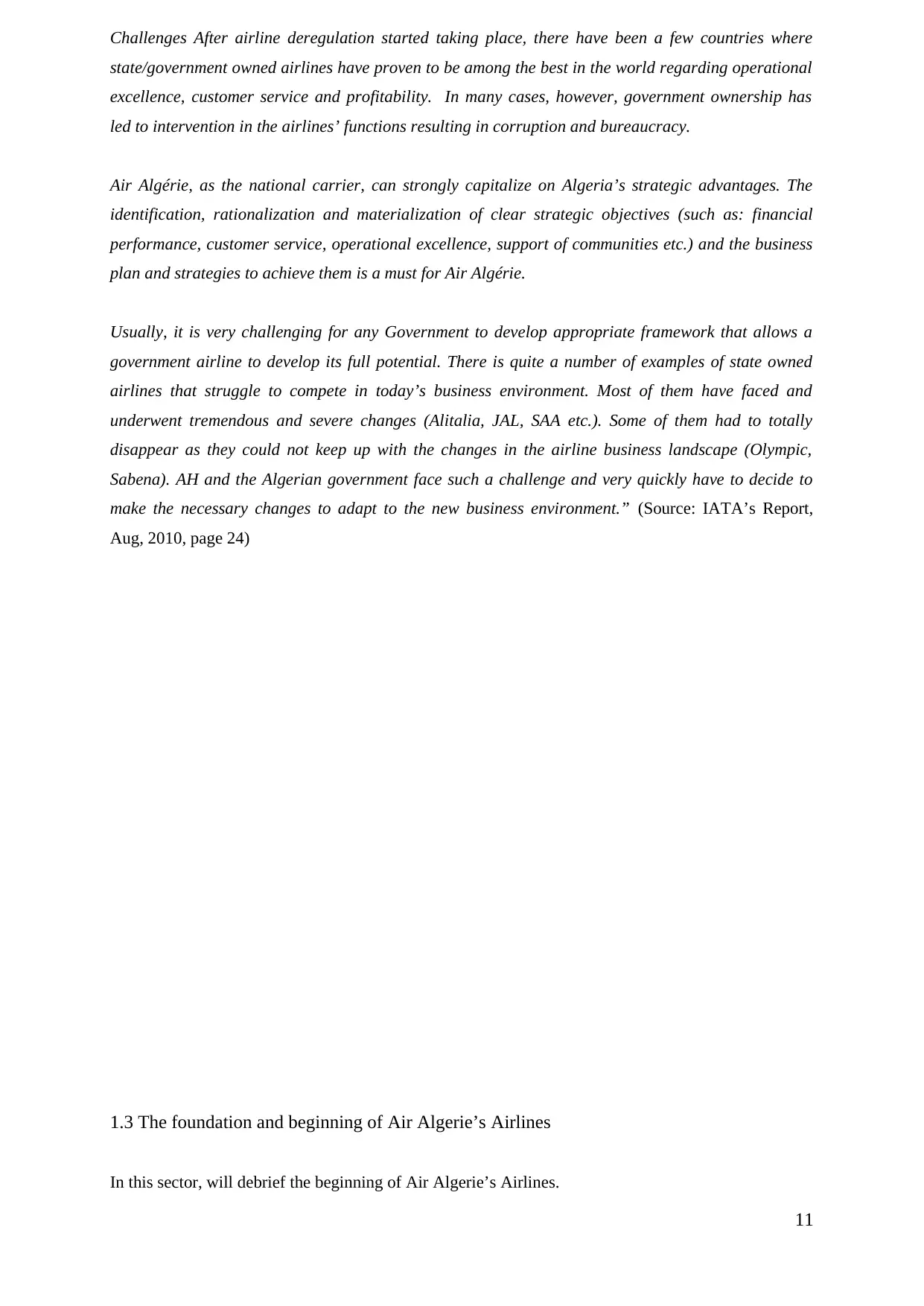
Challenges After airline deregulation started taking place, there have been a few countries where
state/government owned airlines have proven to be among the best in the world regarding operational
excellence, customer service and profitability. In many cases, however, government ownership has
led to intervention in the airlines’ functions resulting in corruption and bureaucracy.
Air Algérie, as the national carrier, can strongly capitalize on Algeria’s strategic advantages. The
identification, rationalization and materialization of clear strategic objectives (such as: financial
performance, customer service, operational excellence, support of communities etc.) and the business
plan and strategies to achieve them is a must for Air Algérie.
Usually, it is very challenging for any Government to develop appropriate framework that allows a
government airline to develop its full potential. There is quite a number of examples of state owned
airlines that struggle to compete in today’s business environment. Most of them have faced and
underwent tremendous and severe changes (Alitalia, JAL, SAA etc.). Some of them had to totally
disappear as they could not keep up with the changes in the airline business landscape (Olympic,
Sabena). AH and the Algerian government face such a challenge and very quickly have to decide to
make the necessary changes to adapt to the new business environment.” (Source: IATA’s Report,
Aug, 2010, page 24)
1.3 The foundation and beginning of Air Algerie’s Airlines
In this sector, will debrief the beginning of Air Algerie’s Airlines.
11
state/government owned airlines have proven to be among the best in the world regarding operational
excellence, customer service and profitability. In many cases, however, government ownership has
led to intervention in the airlines’ functions resulting in corruption and bureaucracy.
Air Algérie, as the national carrier, can strongly capitalize on Algeria’s strategic advantages. The
identification, rationalization and materialization of clear strategic objectives (such as: financial
performance, customer service, operational excellence, support of communities etc.) and the business
plan and strategies to achieve them is a must for Air Algérie.
Usually, it is very challenging for any Government to develop appropriate framework that allows a
government airline to develop its full potential. There is quite a number of examples of state owned
airlines that struggle to compete in today’s business environment. Most of them have faced and
underwent tremendous and severe changes (Alitalia, JAL, SAA etc.). Some of them had to totally
disappear as they could not keep up with the changes in the airline business landscape (Olympic,
Sabena). AH and the Algerian government face such a challenge and very quickly have to decide to
make the necessary changes to adapt to the new business environment.” (Source: IATA’s Report,
Aug, 2010, page 24)
1.3 The foundation and beginning of Air Algerie’s Airlines
In this sector, will debrief the beginning of Air Algerie’s Airlines.
11
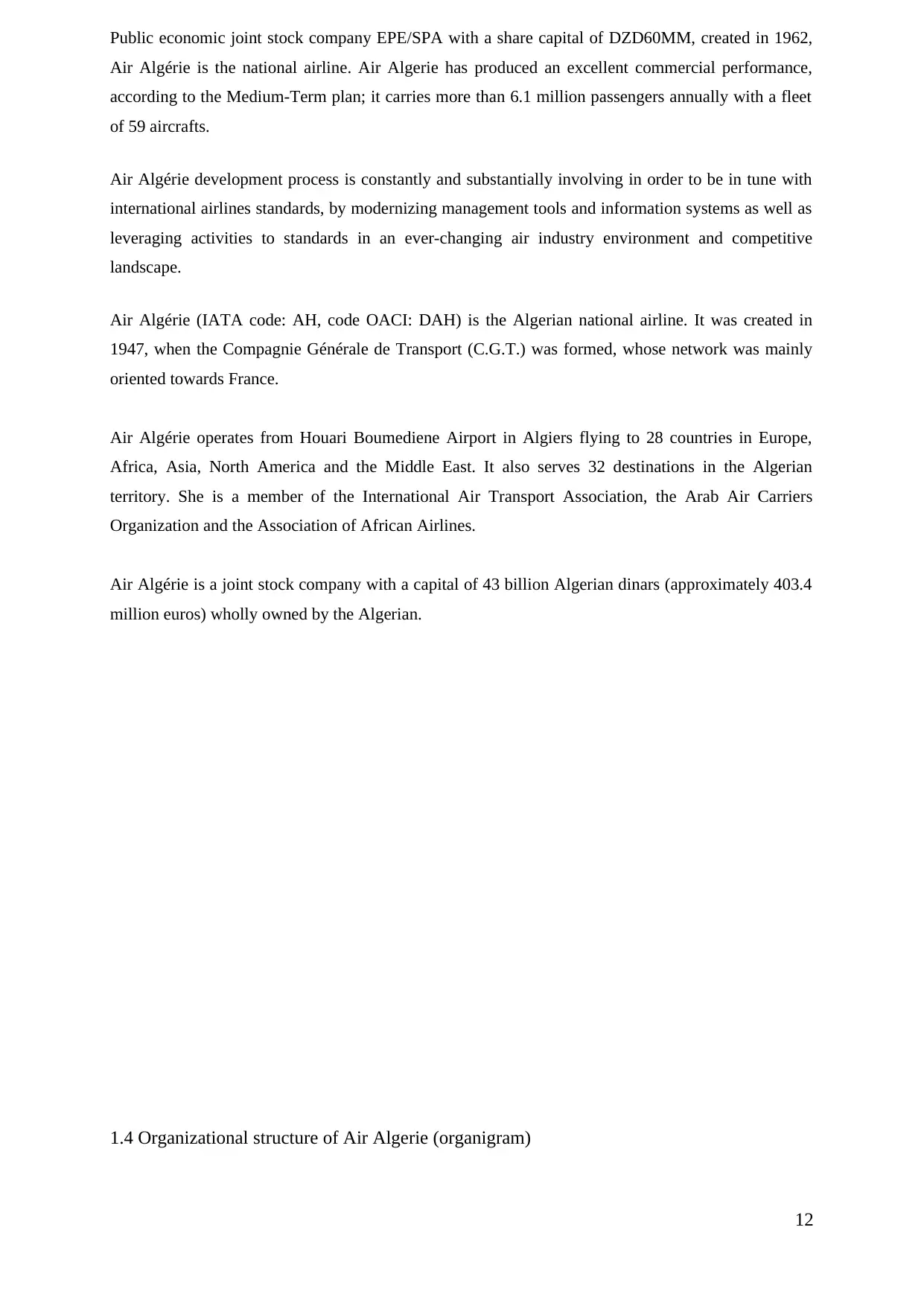
Public economic joint stock company EPE/SPA with a share capital of DZD60MM, created in 1962,
Air Algérie is the national airline. Air Algerie has produced an excellent commercial performance,
according to the Medium-Term plan; it carries more than 6.1 million passengers annually with a fleet
of 59 aircrafts.
Air Algérie development process is constantly and substantially involving in order to be in tune with
international airlines standards, by modernizing management tools and information systems as well as
leveraging activities to standards in an ever-changing air industry environment and competitive
landscape.
Air Algérie (IATA code: AH, code OACI: DAH) is the Algerian national airline. It was created in
1947, when the Compagnie Générale de Transport (C.G.T.) was formed, whose network was mainly
oriented towards France.
Air Algérie operates from Houari Boumediene Airport in Algiers flying to 28 countries in Europe,
Africa, Asia, North America and the Middle East. It also serves 32 destinations in the Algerian
territory. She is a member of the International Air Transport Association, the Arab Air Carriers
Organization and the Association of African Airlines.
Air Algérie is a joint stock company with a capital of 43 billion Algerian dinars (approximately 403.4
million euros) wholly owned by the Algerian.
1.4 Organizational structure of Air Algerie (organigram)
12
Air Algérie is the national airline. Air Algerie has produced an excellent commercial performance,
according to the Medium-Term plan; it carries more than 6.1 million passengers annually with a fleet
of 59 aircrafts.
Air Algérie development process is constantly and substantially involving in order to be in tune with
international airlines standards, by modernizing management tools and information systems as well as
leveraging activities to standards in an ever-changing air industry environment and competitive
landscape.
Air Algérie (IATA code: AH, code OACI: DAH) is the Algerian national airline. It was created in
1947, when the Compagnie Générale de Transport (C.G.T.) was formed, whose network was mainly
oriented towards France.
Air Algérie operates from Houari Boumediene Airport in Algiers flying to 28 countries in Europe,
Africa, Asia, North America and the Middle East. It also serves 32 destinations in the Algerian
territory. She is a member of the International Air Transport Association, the Arab Air Carriers
Organization and the Association of African Airlines.
Air Algérie is a joint stock company with a capital of 43 billion Algerian dinars (approximately 403.4
million euros) wholly owned by the Algerian.
1.4 Organizational structure of Air Algerie (organigram)
12
⊘ This is a preview!⊘
Do you want full access?
Subscribe today to unlock all pages.

Trusted by 1+ million students worldwide
1 out of 46
Related Documents
Your All-in-One AI-Powered Toolkit for Academic Success.
+13062052269
info@desklib.com
Available 24*7 on WhatsApp / Email
![[object Object]](/_next/static/media/star-bottom.7253800d.svg)
Unlock your academic potential
Copyright © 2020–2025 A2Z Services. All Rights Reserved. Developed and managed by ZUCOL.





